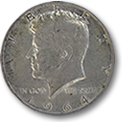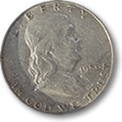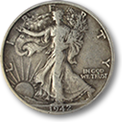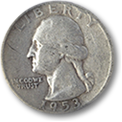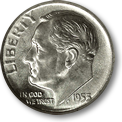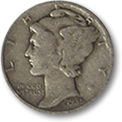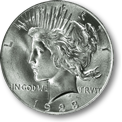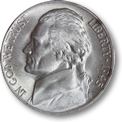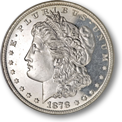
The History of Silver Franklin Half Dollar Coins
The following history of the Benjamin Franklin Half Dollar shows an inner-history about how coins get designed, approved and released into our treasury. The reason the Franklin Halves are unique is because they were the first U.S. coin to feature a non-president. They were also the first place the Liberty Bell was depicted with it's crack in place.Some coin collectors claim that common knowledge on the part of the general public about details of Ben Franklin's contributions and life story are due to the influence of seeing his face on the common half-dollar for sixteen years. Others claim it stood out more because the design of the first Franklin half dollar had a certain edging design called a "full bell line" that flared out slightly, causing them to contain higher volumes of silver, respectively, making them slightly heavier and therefore more valuable than other Mint coins. The coins contain 90 percent silver and ten percent copper.
Issued in 1943, the Franklin Half was circulated until 1963. The desire to honor Benjamin Franklin on a coin began with U.S. Treasury Mint Director Nellie Tayloe Ross. Respected not only for his role as a founding father, Franklin received many accolades for his contributions as a writer, printer, inventor and scientist. The project began in 1947 when Ross commissioned Mint Chief Engraver John R. Sinnock to begin making designs for the half dollar coin. Sinnock had begun his initial drawings before the formal request was initiated, and he died before the coins had been cast into molds.
The new Mint Chief Engraver assigned to the project was Gilroy Roberts. Roberts inherited the task of adding an eagle which is a mandatory part of U.S. Mint coin design since the Coinage Act of 1873. Roberts included an unusually small eagle and added the crack that exists in the Liberty Bell. The office of the U.S. Mint then submitted the coin designs to the Commission of Fine Arts, who rejected the idea of displaying a crack in the liberty bell, and disliked how small the eagle was. The fear from the commission was that design details would invoke ridicule and fuel jokes. The Mint officials and the Treasury Department officials ignored the review and proceeded with Roberts and Sinnock's designs.
Within 16 years, 498 proofs and Benjamin Franklin half dollars were released. Most common coins are not worth anything beyond simple silver value and are often termed "junk silver coins". The "full bell line" in its design helped it hold unique value. It had its lowest production year in 1953 when the Philadelphia Mint produced 2.8 million of them. It was at its highest in 1963 when the Denver Mint struck 67 million of these silver coins for release.
On the obverse side of the Franklin Half is the right facing bust of old Ben himself, with a tiny date just below his chin and Sinnock's signatory; "JRS" below the shoulder. At the top of the coin it reads: "Ben Frankline Half Dollar" and "LIBERTY" on the bottom it reads: "IN GOD WE TRUST".
The reverse side hosts the Liberty Bell including it's now famous crack, with the words "E PLURIBUS UNUM" on the left, and Roberts legally required eagle on the right. At the top the words "UNITED STATES OF AMERICA" on the bottom it reads "HALF DOLLAR". Above the Liberty Bell you can see the U.S. mint-mark.
As politics would have it, when the first release of April 1948 happened, the U.S. Mint received complaints that the JRS signatory stamp was referencing Joseph Stalin. Further implications to communist infiltration seemed to be the cut-off shoulder of Ben Franklin's bust. Regardless of the complaints, the Mint continued production until Kennedy's assassination triggered the need to quickly commemorate his presidency, and the silver Kennedy half dollar coin was born into it's replacement.
The Sesquicentennial half dollar coin typically displays the original Liberty Bell, before it cracked on one side. This half dollar was known as the "Walking Liberty" half dollar and they began to strike these in 1916. This design is what was altered and integrated for the reverse of the Franklin coin. By law, this coin could be replaced without congressional action beginning in 1941, however, heavy demand for coins during times of war prevented any replacement considerations.
Former Mint Director, Nellie Tayloe Ross, was known well as a devout admirer of Benjamin Franklin. She knew that Franklin had opposed the placement of faces on public coins, and theorized that in his day he had only been exposed to royalty who "eternal-ized" themselves in this way. She guessed that since he had participated in the journey that founded the country and had he proceeded to develop with it, he would have lost his objections, and allowed himself to be commemorated.
Sinnock had begun creating Franklin designs in 1933 when he was working on a medal. Some speculate this is the piece that inspired Ross to move forward with the half-dollar coin. The first considerations for a Franklin face began in 1941 when they first considered designs for the silver Mercury dime coin, but this was slowed due to wartime pressures and the minimum time period for submission of the design expired. After the war, it was our fallen president, Roosevelt Franklin, that won the dime. In his day, he had given voice and platform to the March of Dimes, and continuing this legacy seemed to be the strongest current of preference. By then, the Walking Liberty design began seeming old-fashioned to the newer Mint officials. The only other coin eligible to be re-designed was the copper Lincoln penny. This beloved figure and original coin were far too historically significant for Ross to consider becoming responsible for re-designing of the traditional one cent.
Ross placed her first Franklin face request to Sinnock for the half-dollar coin in 1947. The original medal design had been taken from a bust of Franklin that was sculpted by Jeanne-Antoine Houdon. Sinnock had also designed the 1926 Sesquicentennial half-dollar they used for the Franklin reverse. Don Taxay, known as a numismatic writer, uncovered facts suggesting Sinnock's Liberty Bell design came from a sketch produced originally by John Frederick Lewis. Sinnock's death while still in office came just before he completed the reverse-side design. Similar to Sinnock's design for the silver Roosevelt dime, he kept to simple lines, and depicted the period-appropriate suit. The small eagle added later, happened as current officials realized they had forgotten this visual mandate in the Coinage Act of 1873.
As is the required process and mentioned earlier; the designs were submitted to the Commission of Fine Arts for their comments. The Commission was provided with a lead striking of the obverse. To this day some remain uncertain about how they viewed the reverse, but again, the numismatic historical work of Don Taxay suggested they did so by looking at the plaster models. Beginning of December, 1947 the commission acknowledged Sinnock's "good workmanship" but went on to state the unacceptable size of the eagle, and the concern over negative responses to the cracked bell. The Commission countered with a design of their own. Taxay suggests the Treasury Department felt an obligation to honor Sinnock's work, and continued with production using the integrated design.
A press release about the new silver half dollar coin was released in January 7, 1947. Instead of mentioning the Commission denial, they noted Ross's passion for the design and Secretary John W. Snyder's "enthusiastic approval." The press release covered Franklin's thrifty reputation, and expressed hopes that the Franklin half dollar would help remind the public that spare cash can be used to purchase bonds and stamps. As a result, Franklin was the fifth person honored by regular-issue U.S.coin release following Lincoln, Roosevelt, George Washington and Thomas Jefferson making him the first non-president ever honored in this manner.
Ross confessed in a speech, that she had originally felt compelled by various others to try to get Franklin onto the face of the penny, and quoted him verbatim saying "A penny saved is twopence dear" which became the current popular adage; "a penny saved is a penny earned." She countered that the half-dollar is much larger, silver and thus easier to produce as high quality art, which can also impress, which serves to add value. She celebrated her accomplishment by hosting a 200 person dinner party that gifted signed cards containing the new Franklin Halves in them.
To celebrate George Washington's inauguration as president in 1789, the new half dollars became available for sale at noon on April 30, 1948. It began on the steps of the sub-treasury building, by revolution-era clothed patriots depicted by Franklin Savings Bank employees, in New York City.
Because the silver Roosevelt dime was also designed by Sinnock, the signature stamp "JS" had also stimulated conspiracy-related complaints that referenced Stalin. Popular belief postulated that a Kremlin infiltrator worked at the Mint. Changing his signature to "JRS" did little to quell the obsessive. Walter Breen, another numismatic historian, verified the denial response from officials as "outraged." Letters asked The New York Times how the Bureau of the Mint had discovered Stalin's middle name. A shorter-lived rumor was that it would soon be recalled because they failed to capitalize the "o" in of.
Released in small numbers originally, the silver coin became more commonly used by 1957. Demand really increased by 1962 as the "great coin shortage of 1964" was building. These coins hold value, and low-mintage dates were broadly saved. In 1950, the Philadelphia Mint began to strike proofs. Frosted surfaced "Cameo proofs" had frosted surfaces. Mirror-like fields carry a premium when struck in small numbers, and so it was. In the end there were just under 498 million Franklin Halves with proofs released.
At one time a die cast error created a line that came to be known as the "Bugs Bunny" half. A reverse die impacting another die caused eagle wing disruptions appearing like bucked teeth on Franklin's face. This meant dies used in the late 1950's were wearing out, and were causing a slowed production. The Mint responded by re-cutting the master dies for a higher quality result by 1960.
Following the assassination of Kennedy in 1963, the Mint moved in tandem with Congress to speedily consign and produce a presidential tribute coin. Authorized into production by December 30, 1963, the Kennedy half dollar flowed into public hands and the last of the Franklin Halves were finally released.
The final rumors circulating were of 1964 Franklin Halves out in public, but numismatic historian, Breen, posed that it could only have been die-test strikes dated 1964. There is still no proof for this theory.
These historical coins are now collectors items. However, except for the higher quality versions, most are valued only at their inherent silver metal content and considered junk silver coins. Unfortunately, many have been melted for their silver value.








